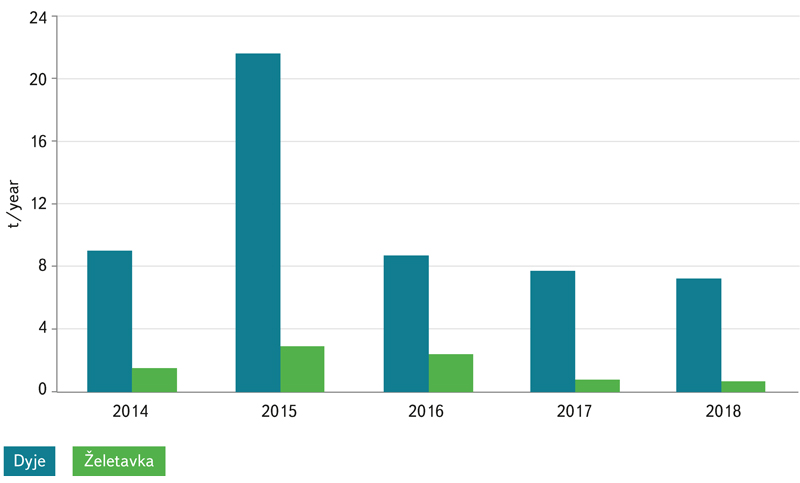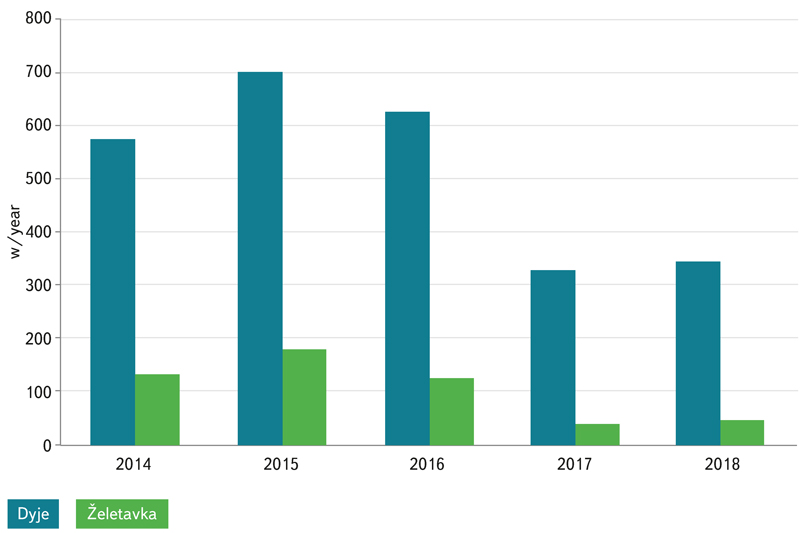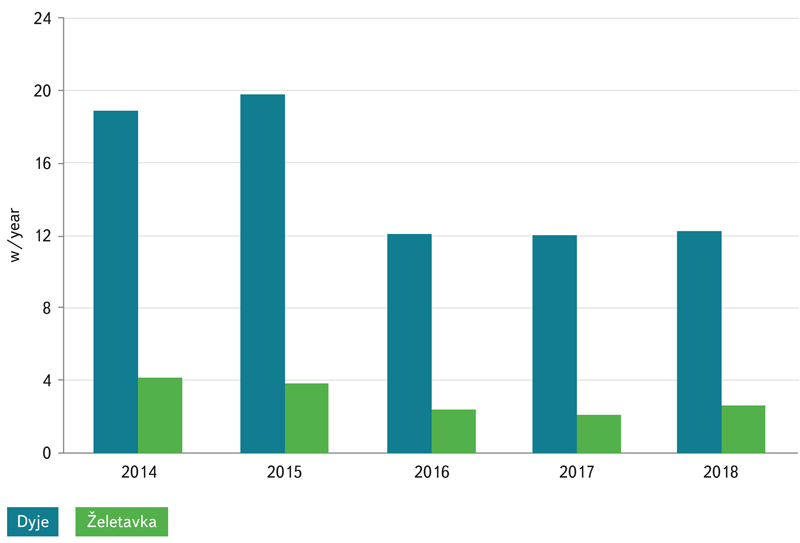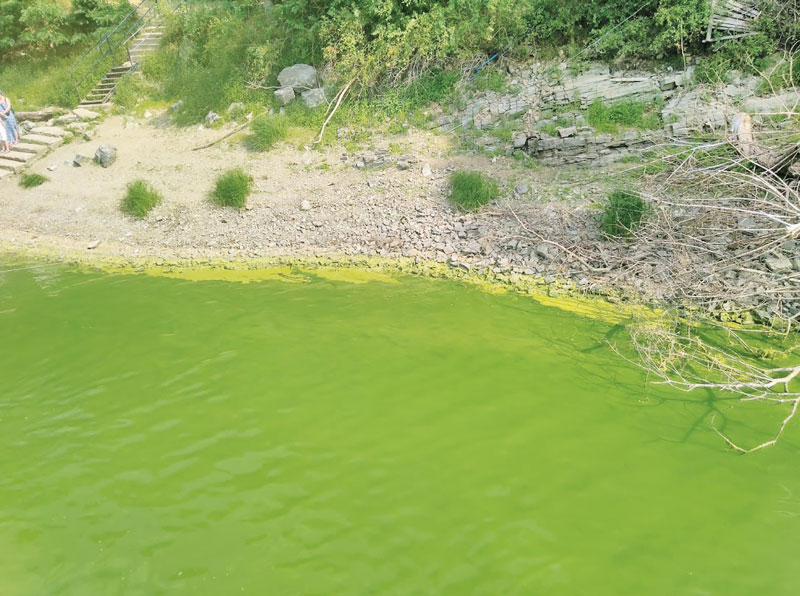Most of the reservoirs in the Czech Republic have been built as multifunctional reservoirs, with the basic functions being storage and protection. The way the catchment area upstream of a reservoir is used has a significant impact on water quality. Pollution sources can be divided into point, area, and diffuse sources. Being continuous or recurrent, point pollution is not significantly influenced by meteorological factors and it is linked to narrowly delimited areas such as settlements, wastewater treatment plants (WWTPs), industrial plants, agricultural facilities, etc. Area pollution is difficult to observe as it is irregular and depends on meteorological, soil, morphological, and vegetation characteristics [4]. The category of diffuse sources usually includes small diffuse point sources of pollution, namely municipal, agricultural, industrial, as well as traffic pollution, leachates from landfills, etc.
A number of reservoirs are currently facing the problem of eutrophication. This is considered a process of complex changes in natural waters caused by nutrient enrichment. It leads to the development of toxin-producing cyanobacterial bloom. In eutrophicated waters, the accumulated biomass collapses and, at the same time, the oxygen concentration in the water decreases, which in turn leads to fish deaths. Phosphorus and nitrogen are nutrients of concern in terms of eutrophication, with phosphorus being the predominant nutrient in most surface waters in the Czech Republic. At present, about 70% of active phosphorus comes from point sources (mainly municipal), while in the case of nitrogen this figure is only 20% [2]. Nowadays, the consumption of mineral fertilisers and the application of manure fertilisers have a lesser impact on phosphorus pollution. The amount of phosphorus input to agricultural land has decreased over the last 25 years, but wastewater from WWTPs remains a risk [2].
Specific pollutants such as pesticides, pharmaceuticals, microplastics, and personal care products are also a current problem in relation to surface water pollution. They often do not degrade in water, but they have do a negative impact on aquatic organisms. Drinking waters are also burdened with specific pollutants [1].
VRANOV WATERWORKS
Vranov hydraulic structure on the river Dyje was put into operation in 1934. The hydrological catchment area of the reservoir is 2,211.8 km2, almost half of which is in Austria. In the Czech Republic, the catchment area is 1,159 km2 in four districts and three regions. In terms of land use, it is comprised of agricultural land (60.2% of the catchment´s total area), forest land (31%), water areas including the actual floodplain (2.5%), urban areas (0.9%), and other land (5.4%) [6].
This major waterworks is multi-purpose and that is why there are often conflicts of interest. Its main functions include flood protection, power generation, recreation, sport fishing, navigation, as well as drinking water supply, which was not its primary function at the beginning because the water intake was not built here until 1982. The collection structure is located on a floating pontoon 3.9 km from the dam. The joint-based connection between the pontoon and the bank allows the movement of the reservoir surface to be followed, thus allowing the optimum depth for raw water intake to be used (Fig. 6). The drawn raw water is then treated at Štítary treatment plant, with a capacity of 200 l/s. The group water supply system leading from the Štítary plant currently supplies drinking water to more than 80,000 inhabitants in the adjacent regions of South Moravia and the Highlands. The water reservoir is administered by the Morava River Basin Authority (Povodí Moravy). The raw water collection device is the property of the Water Supply and Sewerage Association of Municipalities, based in Třebíč, and the operator of the group water supply system, including the water intake and water treatment plant, is VAS, Co. [7].
The balance evaluation of selected water quality indicators was carried out for the Dyje and its largest tributary the Želetavka (in the profiles Dyje Podhradí and Želetavka) for the period 2014–2018. The following parameters were evaluated: ammonia nitrogen, nitrate nitrogen, orthophosphates, total phosphorus, and selected pesticides and their metabolites: terbuthylazine, metolachlor ESA, metazachlor ESA, metazachlor OA. Data on the concentrations of the selected water quality parameters were provided by the Morava River Basin Authority (Povodí Moravy), and the flow rate values for the period concerned were provided by the Czech Hydrometeorological Institute. Annual average concentrations were calculated for the monitored indicators and compared with the limits according to Government Decree 401/2015 Sb., as amended. The average annual flow rates on the Dyje and the Želetavka were calculated from the daily flows. Balances were then expressed on the basis of the average annual flow rates and concentrations for the monitored water quality indicators for 2014–2018.
RESULTS
The limit for the average annual concentration of ammonia nitrogen is 0.23 mg/l, according to Government Decree 401/2015 Sb. This limit has been neither reached nor exceeded in any year on the Dyje or the Želetavka. The highest detected concentrations were up to 0.12 mg/l. A more significant difference in concentrations between the Dyje and the Želetavka was found only in 2016, when the annual average concentration was almost twice as high on the Želetavka. In the other years, there were no significant differences between the two watercourses. The ammonia nitrogen balance evaluation is shown in Fig. 1. The results show that significantly more ammonia nitrogen flows into the Vranov reservoir through the Dyje Podhradí profile than through Želetavka profile, which is caused by much higher flows on the Dyje.

Fig. 1. Ammonia nitrogen balance evaluation 2014–2018
The average annual concentration of nitrate nitrogen was always higher on the Želetavka than on the Dyje. The limit value of 5.4 mg/l was exceeded only once in the period concerned, namely in 2016, when the average annual concentration on the Želetavka was almost 6 mg/l (Fig. 2).

Fig. 2. Nitrate nitrogen balance evaluation 2014–2018
Phosphorus appears to be a problematic water quality indicator. According to Government Decree 401/2015 Sb., the limit for average annual concentration of total phosphorus is 0.05 mg/l for bathing water and water to be used as tap water. The graph in Fig. 3 shows that this limit was significantly exceeded in both watercourses during the whole monitoring period; there were always higher concentrations in the Želetavka. The water in the Dyje is diluted by cleaner water from Austria. The monitored parameters also include orthophosphates. However, legislation does not specify limit values for this, although it is an important indicator in the context of eutrophication (a useful source of phosphorus for algae and cyanobacteria). For both total phosphorus and orthophosphates, concentrations were always higher in the Želetavka, almost doubled in the dry years of 2017 and 2018.

Fig. 3. Ptotal annual average concentration (from monthly measurement) according to Government Decree 401/2015 Sb.
The following graph in Fig. 4 shows how many tonnes of total phosphorus flowed into the reservoir from the Dyje and the Želetavka rivers during the period concerned. Fig. 3 and Fig. 4 show the drought problem in 2017 and 2018. Despite the high average annual concentration in these years (Fig. 3), not as many tonnes of total phosphorus flowed into the reservoir as in previous years due to lower flow rates (Fig. 4). The impact of the drought was also obvious for ammonia nitrogen and nitrate nitrogen (Fig. 1 and Fig. 2).

Fig. 4. Ptotal balance 2014–2018.
Concentrations of selected pesticides and their metabolites were not monitored regularly. The limits according to Government Decree 401/2015 Sb., the average annual concentrations of terbuthylazine, metolachlor ESA, metazachlor ESA and metazachlor OA on the Dyje Podhradí profile were not exceeded. On the Želetavka profile the limit value was only exceeded in 2018 for metazachlor ESA. Regarding the balance of monitored pollutants, most data were available for terbuthylazine and metolachlor ESA. For the monitoring period 2014–2018, 5–10 kg/year of terbuthylazine got into the reservoir from the Dyje and 1–4 kg/year from the Želetavka. Metolachlor ESA was also monitored on the Dyje throughout the monitoring period; here, the balance ranged from 5 to 12 kg/year. On the Želetavka, metalachlor ESA was only monitored in 2016 and 2018, with a balance of 3 kg/year and 1 kg/year, respectively.
In 2017, 24 kg of metazachlor ESA were brought into the reservoir by the Dyje; in 2018 it was 32 kg by the Dyje and 6 kg by the Želetavka. In 2017 it was 5 kg of metazachlor OA (Dyje); in 2018 it was 6 kg by the Dyje and 2 kg by the Želetavka.
The results show that the most problematic water quality indicators include the presence of pesticides and total phosphorus, which causes excessive eutrophication of the reservoir (Fig. 5). The main source of pesticides is agricultural activity in the catchment upstream of the reservoir.

Fig. 5. Algal bloom in Bítov Bay
According to the above results, the balance values of Ptotal for 2014–2018 range from 12 to 20 t/year on the Dyje, with an average annual concentration of 0.110 mg/l, and from 2 to 4 t/year on the Želetavka, with an average annual concentration of 0.1514 mg/l. Hanák [3] focuses on the years 2009–2013 and reports that the Dyje brings to the reservoir on average 30.6 t of Ptotal per year, with an average annual concentration of 0.110 mg/l; the Želetavka brings 5.3 t of Ptotal, with an average annual concentration of 0.135 mg/l. In 2014–2018, the phosphorus contribution is lower, which may be mainly due to the fact that the flow rates were lower than those in previous years. Hanák also states that area sources of pollution (agricultural land) are not a significant source of phosphorus in the Vranov hydraulic structure catchment. The main polluters are point sources (79%), compared to area sources (21%). There are no intensive breeding ponds in the catchment and industry does not have a significant impact on water quality either. The main source of phosphorus is wastewater. There are 27 WWTPs in the Vranov catchment, but most of them lack phosphorus precipitation [3].
There are almost 5,000 buildings used for recreation in the wider area of the reservoir, and almost 1,000 in the immediate vicinity of the reservoir; however, sanitary sewerage systems are only located at the Vranov and Bítov reservoirs. Some buildings that lack connection to the sewerage system are not accessible for a gully emptier. As a result of wastewater disposal, detailed procedures and the principle of precautionary protection of the water resource are part of the management regime in water resource protection zones if an owner of a building is interested in its repair, reconstruction, extension, etc.
In the context of recreation, another risk to water quality is the handling of petroleum products, not only by vehicles on access roads and farm tracks, but also directly on the surface of the reservoir by public and private shipping. There are also a lot of chainsaws, lawnmowers, power generators, etc., that create this risk, which would be marginal in many other cases, but significant in view of the developed recreational sector and the number of buildings in use.
CONCLUSION
The measures to reduce phosphorus concentrations must be based on building sewerage in communities where it is lacking, reconstruction of existing leaking sewerage systems and cesspools, and design of new WWTPs or upgrading of existing ones (with phosphorus precipitation included). However, it should be stressed that all existing WWTPs meet the limits set for the Ptotal in the discharge of wastewater to surface waters. This is due to the weak legislation which does not set Ptotal limits for all sizes of municipal WWTPs, but only for those with a population equivalent of more than 2,000.
The issue of pesticides and their metabolites is not only a problem in the Vranov reservoir; their findings can also be documented, for example, in groundwater sources or water supply reservoirs [5].
Water intake (Fig. 6) from the Vranov multipurpose reservoir is promising and irreplaceable; however, the reservoir is the only case of such an enormous multipurpose character in the Czech Republic. That is why it is necessary to adapt the protection of the yield, quality, and safety – of this source to its uniqueness.

Fig. 6. Collection structure located on a floating pontoon
Acknowledgements
The authors thank the Povodí Moravy State Enterprise for providing data.
